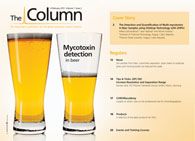Reanalysing Viking results
In 1976 the Viking landers took samples of the soil on Mars and analysed it for organic compounds. Traces were dismissed as contamination, however a reinterpretation of the results suggests significant levels were present, hidden by the strong oxidation effect of salt in the Martian soil.

In 1976 the Viking landers took samples of the soil on Mars and analysed it for organic compounds. Traces were dismissed as contamination, however a reinterpretation of the results suggests significant levels were present, hidden by the strong oxidation effect of salt in the Martian soil.
In the Viking tests the landers heated the soil to vapourize organic compounds and the results were analysed by GC–MS. As well as small amounts of water and carbon dioxide, traces of chlorohydrocarbons were detected, but were dismissed. But in 2008, the Phoenix lander discovered perchlorates — powerful oxidizing compounds that combust organics — in the Martian Arctic soil.
A study published in the Journal of Geophysical Research1 took Mars-like soil from the Atacama Desert in Chile, which contained organic carbon, and mixed it with magnesium perchlorate. When heated, nearly all of the organics present were decomposed to water and carbon dioxide, but a small amount formed the same kinds of organic hydrocarbons detected in the Mars samples.
A chemical kinetic model was produced to predict the degree of oxidation and chlorination of organics in the Viking oven. Using the model to reinterpret the results suggests that samples from landing site 1 contained 1.5–6.5 ppm, while site 2 samples contained 0.7–2.6 ppm.
According to the study this discovery of organics will provide important information for future Mars missions looking to detect life itself.
1. R. Navarro-González, J. Geophys. Res., 115, E12010 (2010).
This story originally appeared in The Column. Click here to view that issue.
A Novel LC–QTOF-MS DIA Method for Pesticide Quantification and Screening in Agricultural Waters
May 8th 2025Scientists from the University of Santiago de Compostela developed a liquid chromatography quadrupole time-of-flight mass spectrometry (LC–QTOF-MS) operated in data-independent acquisition (DIA) mode for pesticide quantification in agriculturally impacted waters.
Investigating 3D-Printable Stationary Phases in Liquid Chromatography
May 7th 20253D printing technology has potential in chromatography, but a major challenge is developing materials with both high porosity and robust mechanical properties. Recently, scientists compared the separation performances of eight different 3D printable stationary phases.

.png&w=3840&q=75)

.png&w=3840&q=75)



.png&w=3840&q=75)



.png&w=3840&q=75)









